A Riot of Colour & Celebration – The Perfect Indian Wedding
It’s universally known that Indian weddings are one of the grandest in the world – even Vogue admits it! If you’ve been invited to one or are simply planning your wedding, get ready for the most amazing party of your life.
The ceremony is grand – full of traditions and colours, so it’s no surprise that you may feel a little lost and need help understanding the customs. A typical Indian wedding party is one of the most welcoming events in the world – so don’t worry; you’ll fit right in.
It’s not uncommon for Indian weddings to last for days, with musicians and dancers performing to the delight of all guests. A traditional Indian wedding is like a celebration for the ages at majestically decked wedding venues, like it’s a Vogue ballroom, filled with beautifully ordained guests.
Here’s your quick guide to planning or attending one of the most magnificent wedding parties in the world.
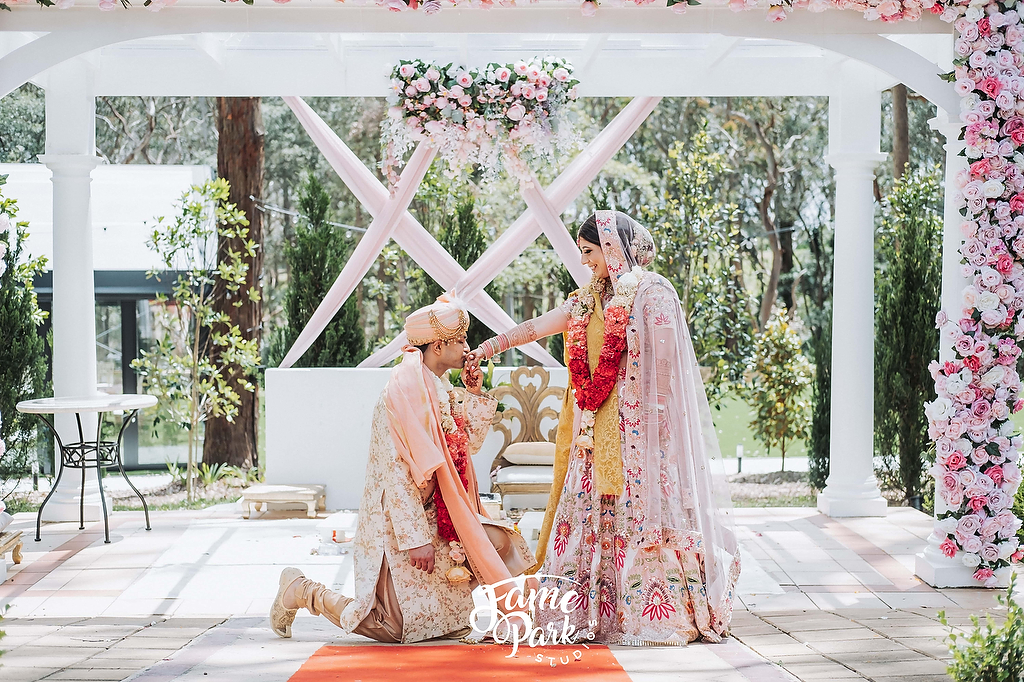
Traditional Indian Wedding Functions
In India, weddings take many different forms. Every corner of the country boasts a unique set of cultural influences which affect the production and planning of a wedding.
But no matter the region or religion, Indian Weddings are known for their incredible luxury and extravagance. Though Indian marriages are celebratory events in any circumstance, they are marked by different traditions and customs in each region. As we all know, no two weddings, Indian especially, is the same, and here’s how you can differentiate:
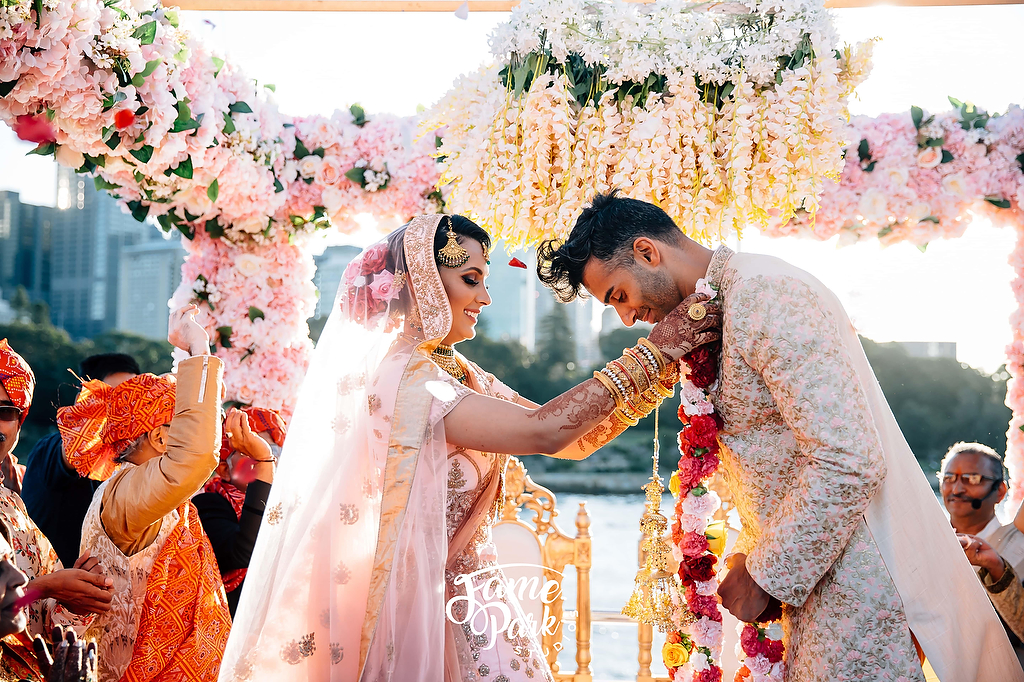
Hindu Wedding Traditions
India boasts a large, tight-knit community of Hindus, and their weddings are never dull. This country is rich in culture and is also home to the biggest Hindu community in the world.
India’s diverse Hindu population makes it a country with rich wedding traditions. Hindu weddings are steeped in tradition and beautiful meaning, from pre-wedding rituals like the Mehendi and Sangeet to wedding day practices of Veda and the likes of the Baraat and Kanyadaan.
Sikh Wedding Traditions
The Indian wedding culture is incredibly diverse, representing the many communities that make up the subcontinent. For instance, Sikh weddings are unique because they do not require a ceremonial fire.
The bride Indian wedding and groom circle a sacred book four times instead of the seven customary in the Hindu faith. Guests of such a wedding are expected to sit below the holy book, so plush cushions are often laid out for seating purposes.
Jain Wedding Traditions
Jainism is the sixth most popular belief system in India, and their wedding ceremonies are quite distinct from the other religions practised in the country. For instance, the Ghudchadi is a processional comparable to the Baraat in Hindu ceremonies, with the groom’s Barat or Barati on a white horse. Sva Graha Aagamana is a post-wedding tradition that includes a visit to a temple and donating alms to those in need. This is the final step before the lavish wedding reception.
Muslim Wedding Indian Traditions
In a Muslim Indian wedding, the bride and groom do not have to be together when making their marriage vows. Instead, the fathers of both the bride and groom make promises to accept all the blessings for their children on their behalf. Following this, Nikaah is performed before the pair can finally take their places side by side as husband and wife.
Marathi Wedding Traditions
It’s very interesting to see how different regions of the country observe different wedding traditions. For instance, the central Indian state of Maharashtra observes wedding rituals that involve sugar and coconut-based practices and grain offerings into a sacred fire by the couple, among others. These practices reflect the region’s faith, beliefs and customs.
Bengali Wedding Traditions
The culturally rich region of the subcontinent, Bengal, is home to vibrant artistic customs. In this land of Indian maestros of art and culture, weddings take a beautiful turn. In this Indian wedding, traditional practices such as Haldi and Saptapadi remain similar to most Hindu celebrations. However, this Indian wedding celebration is marked with ceremonies that symbolize and celebrate holy matrimony in subtle ways, unlike weddings around the country.
Punjabi Wedding Traditions
No one does weddings as the Punjabis do! Full of gusto and merriment, Punjabi weddings are vibrant, loud, and filled with over-the-top celebrations. It is the best Indian-style wedding you can attend! Get ready for Indian wedding days that are brimming with nothing, but loud music, good food, and a venue filled with guests who love to party.
South Indian Wedding Traditions
India is a country full of colour and ritual. From the vast swaths of land that make up the country, each state has its own traditions. And yet all of India is united in celebration and pride, whether it be the colours on their saris or the sound of their laughter.
There are many wedding traditions in South India. While some rituals are common to multiple communities, the list of ethnicities and traditions is astronomically long. Each region introduces its own flavour through their customs and practices. If you want your friend’s South Indian wedding ceremony explained, feel free to direct your questions to the priest and learn more about this fascinating region.
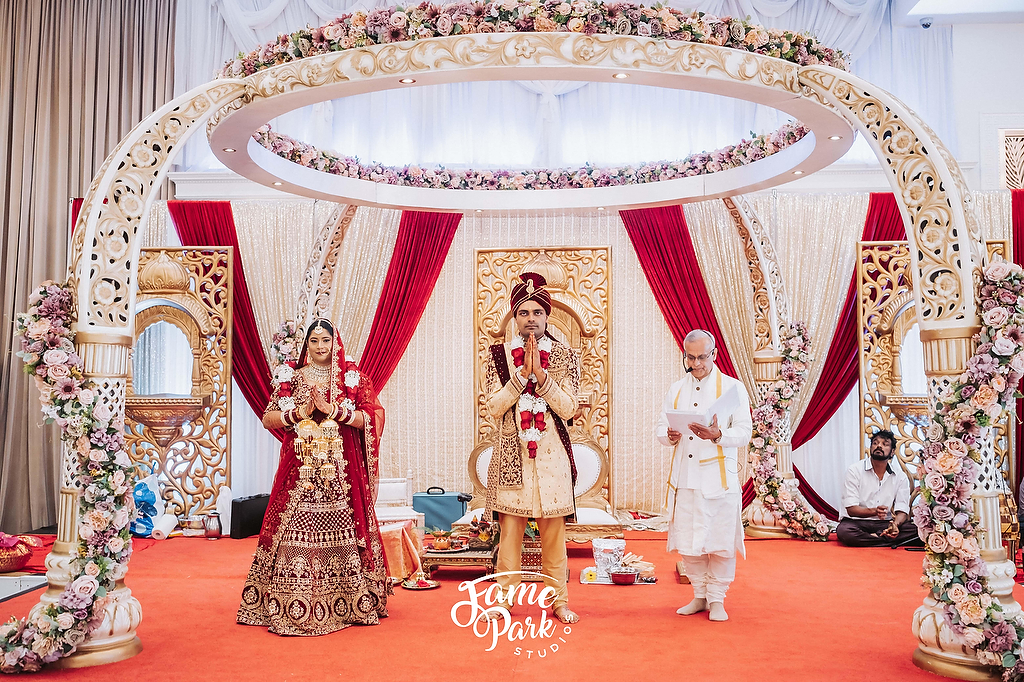
Common Indian Wedding Traditional Practices
From the gorgeous, flowing lehenga to the intricate Mehendi and the part where everyone dances together, Indian weddings are a grand, extravagant spectacle. A typical Indian wedding is not just a highly ritualistic affair but a celebration that doesn’t end with the reception—it has first-day, second day and even third-day celebrations.
Wedding traditions may differ from region to region, and there are a few pre-wedding affairs that you may notice that are common among weddings, such as Mehendi, Sangeet and Haldi. Read on for a quick preview of the Indian wedding ceremonies in order to be perfectly ready to have the best time.
Wedding Dates and Timings
The Hindu belief about life is that everything is governed by the universe, including their marriages. So it’s not uncommon to see the importance of astrology in a Hindu Indian wedding. As an ode to ensure that the couple lives a long and happy life together, most Indian wedding planners often use astrological readings as one of the most critical aspects of the wedding ceremony.
A Indian wedding is a ceremony steeped in tradition. Therefore, practices like consulting an astrologer to determine a couple’s compatibility or finding the most auspicious time to wed have been a part of the culture for hundreds of years.
Traditional Indian Wedding Functions
An Indian wedding is a long and intricate affair simply because of the number of rituals involved. It’s impossible to fit them all into one day, so you have several wedding days!
Some of the common rituals you will notice at an Indian wedding include a Mehendi ceremony which includes decking the hands of an Indian wedding bride and her guests using Henna to make intricate and beautiful designs. Commonly associated with jovial spirits and good luck, this ceremony takes place the night before the wedding to wish the bride health and prosperity in her marriage.
Another typical ritual for a Hindu wedding bride and groom is the Haldi ceremony. It is believed that Haldi or turmeric paste will cleanse the couple’s soul before they step into holy matrimony.
You may also find an invitation to a ceremony called Sangeet which may be one of the most fun Indian wedding customs to exist. Sangeet translates to “sung together” in Sanskrit. As an Indian wedding ceremony, it’s an occasion of celebration with music and dance of not just the holy union of the couple, but also two families.
Grand Entrances
Indians know how to live life large, so naturally, their weddings will only be grand affairs and nothing else. If you have watched enough Bollywood or have Indian friends who do, you may be familiar with the idea of Indian extravagance in every sphere of life.
If not, here’s a quick peek! In any Indian traditional wedding, the to-be husband and wife must make grand entrances. The groom usually makes a splendid entrance – arriving on a horse-drawn carriage and a bustling group of his loved ones dancing to a wedding band. At the same time, the bride prepares for a grand reveal as she walks down the aisle or is regally carried in the arms of her father or uncle.
It’s a beautiful moment that guests wait to witness with bated breaths, just like you will too.
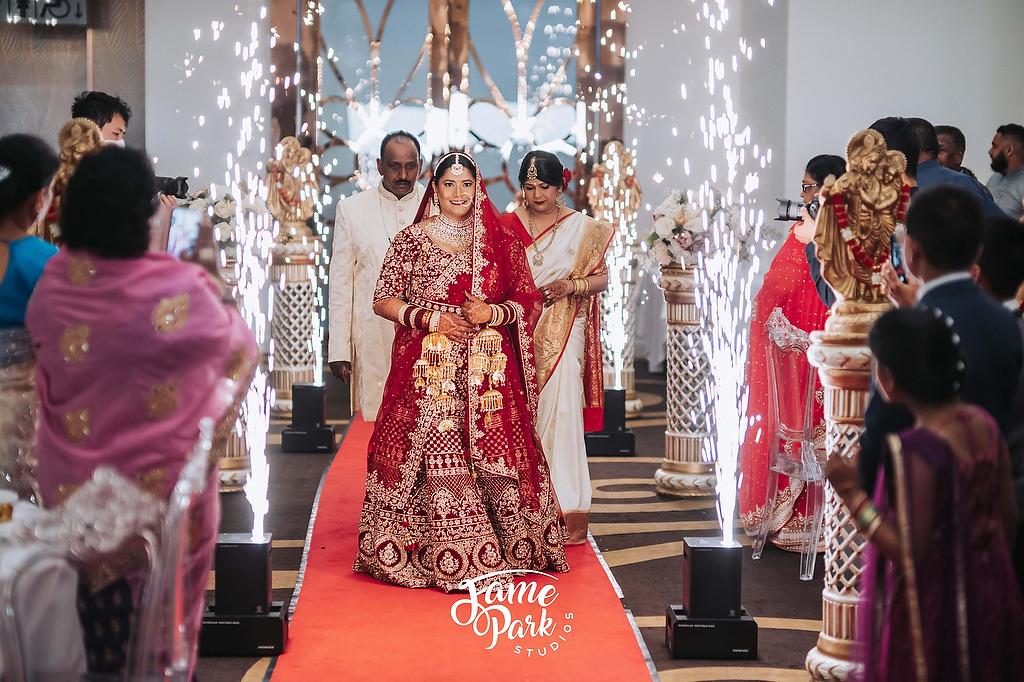
Traditional Indian Wedding Customs
From bespoke outfits and exquisite jewellery to exquisite food and a beautiful venue, a luxury Indian wedding is almost always dazzling. And the best part, traditional Indian wedding rituals have been passed down through generations with the same motive: showering the couple with fortune, good health, and prosperity.
Most Indian wedding customs reflect this ideology through practices such as ‘jai mala’, where the groom and bride exchange floral garlands as a mark of acceptance of their unity and as a pledge of respect for each other. The ‘hasta melap’ custom includes the groom’s scarf tied to a portion of the bride’s outfit to mark the union of the two’s mind, body and soul.
Several mantras are expressed and exchanged between the couple during the wedding ceremony, which is essential prayers and wishes for a lifetime of happiness and prosperity.
Other prominent wedding customs include the ‘mangal phera’, where the couple join hands and take four steps around the ceremonial fire representing steps of life such as religious and moral duty, prosperity, earthly pleasures and spiritual salvation, and ‘saptapadi’, where the couple takes the first seven steps towards a lifetime of togetherness.
Indian Wedding Outfits
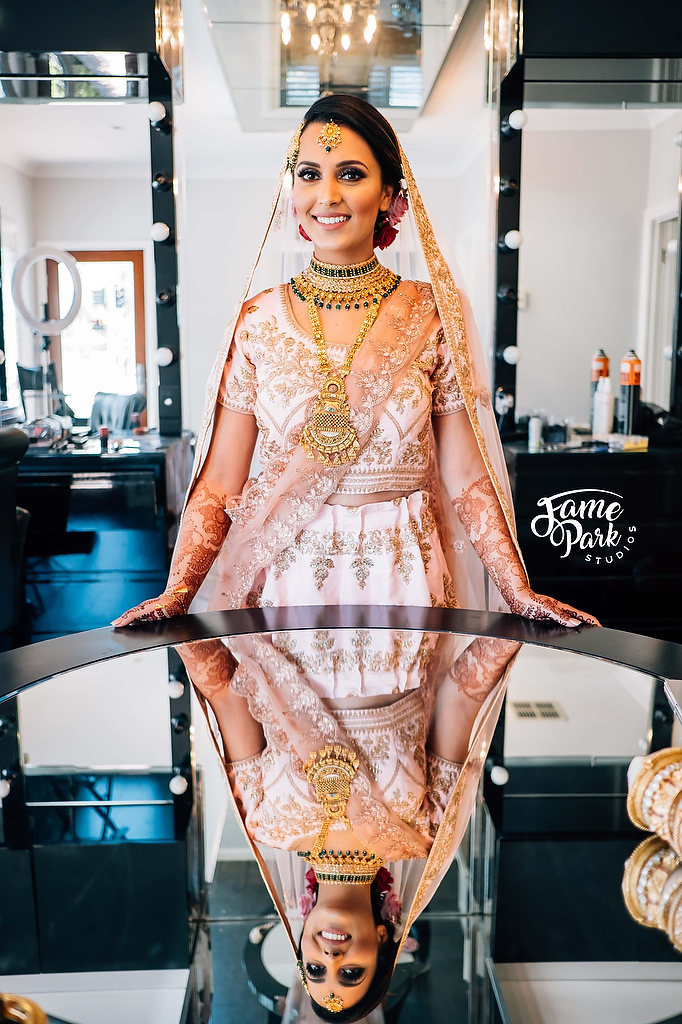
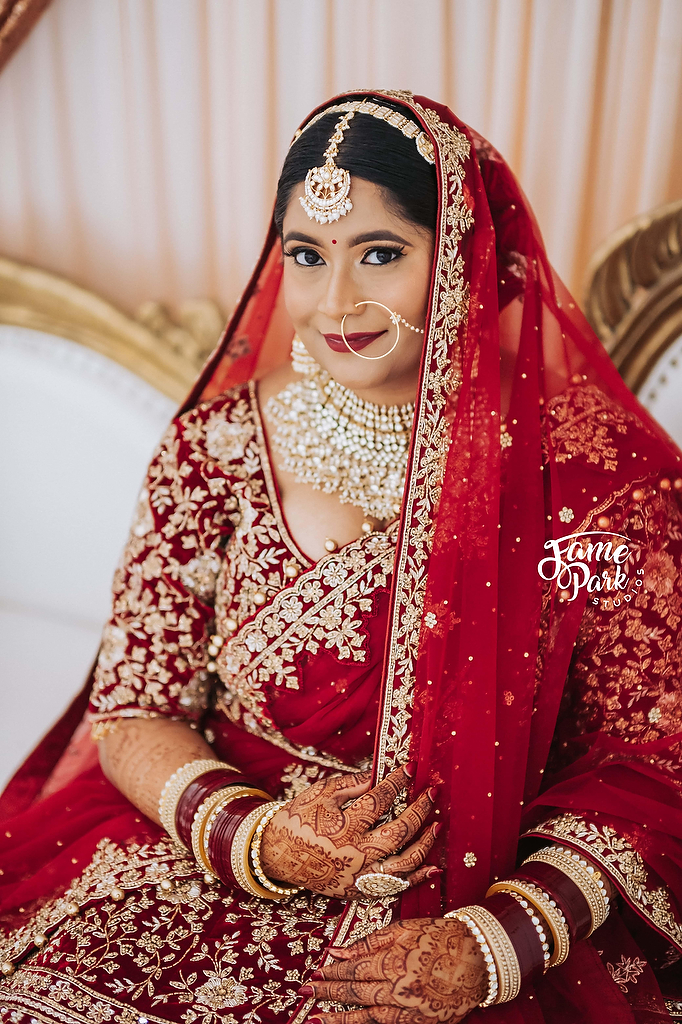
A significant part of an Indian wedding service is outfits adorned by the couple and the wedding party. A typical Indian bride will be adorned in different shades of red. Any Hindu wedding ceremony explanation will tell you that the colour red holds the highest importance. Alluring to a warrior Goddess, this colour signifies love, commitment, strength and bravery.
The groom is usually dressed in typical Indian attire, such as gorgeous sherwanis or kurtas, like most of the wedding guests. If you don’t want to stand out at an Indian wedding, it’s ideal that you, too, get yourself a traditional Indian outfit.
All About Indian Wedding Traditions to Get Your Started
Whether you are attending the wedding of Indian friends and colleagues or planning an Indian style wedding for yourself, here’s your quick preview into the fascinating Indian wedding culture. Melbourne is home to some of the biggest Indian populations in Australia, so it’s no surprise if you’ve received one or more Indian wedding invitations already.
Nevertheless, an Indian wedding is an experience of a lifetime. So, gear up, and let’s get you ready for the biggest wedding party of the year! Here’s all that you need to know about Indian weddings.

